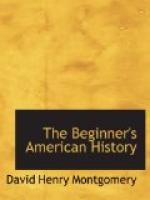[Illustration: ONE KIND OF TELEGRAPH.]
Suppose you take a straight and stiff piece of wire as long as your desk and fasten it in the middle so that the ends will swing easily. Next tie a pencil tight to each end; then put a sheet of paper under the point of each pencil. Now, if you make a mark with the pencil nearest to you, you will find that the pencil at the other end of the wire will make the same kind of mark. Such a wire would be a kind of telegraph, because it would make marks or signs at a distance. Mr. Morse said: I will have a wire a mile long with a pencil, or something sharp-pointed like a pencil, fastened to the further end; the wire itself shall not move at all, but the pencil shall, for I will make electricity run along the wire and move it. Mr. Morse was then a professor or teacher in the University of the City of New York. He put up such a wire in one of the rooms of the building, sent the electricity through it, and found that it made the pencil make just the marks he wanted it should; that meant that he had invented the electric telegraph; for if he could do this over a mile of wire, then what was to hinder his doing it over a hundred or even a thousand miles?
[Illustration: PROFESSOR MORSE AT WORK MAKING HIS TELEGRAPH.]
[Footnote 3: Telegraph (tel’e-graf): this name is made up of two Greek words, the first of which means far off, and the second to write.]
223. How Professor Morse lived while he was making his telegraph.—But all this was not done in a day, for this invention cost years of patient labor. At first, Mr. Morse lived in a little room by himself: there he worked and ate, when he could get anything to eat; and slept, if he wasn’t too tired to sleep. Later, he had a room in the university. While he was there he painted pictures to get money enough to buy food; there, too (1839), he took the first photograph ever made in America. Yet with all his hard work there were times when he had to go hungry, and once he told a young man that if he did not get some money he should be dead in a week—dead of starvation.
[Illustration: A COPY OF THE FIRST PHOTOGRAPH MADE IN AMERICA. (The tower of the Church of the Messiah, in New York. The church is no longer standing.)]
224. Professor Morse gets help about his telegraph; what Alfred Vail did.—But better times were coming. A young man named Alfred Vail[4] happened to see Professor Morse’s telegraph. He believed it would be successful. He persuaded his father, Judge Vail, to lend him two thousand dollars, and he became Professor Morse’s partner in the work. Mr. Vail was an excellent mechanic, and he made many improvements in the telegraph. He then made a model[5] of it at his own expense, and took it to Washington and got a patent[6] for it in Professor Morse’s name. The invention was now safe in one way, for no one else had the right to make a telegraph like his. Yet, though he had this help, Professor Morse did not get on very fast, for a few years later he said, “I have not a cent in the world; I am crushed for want of means.”




